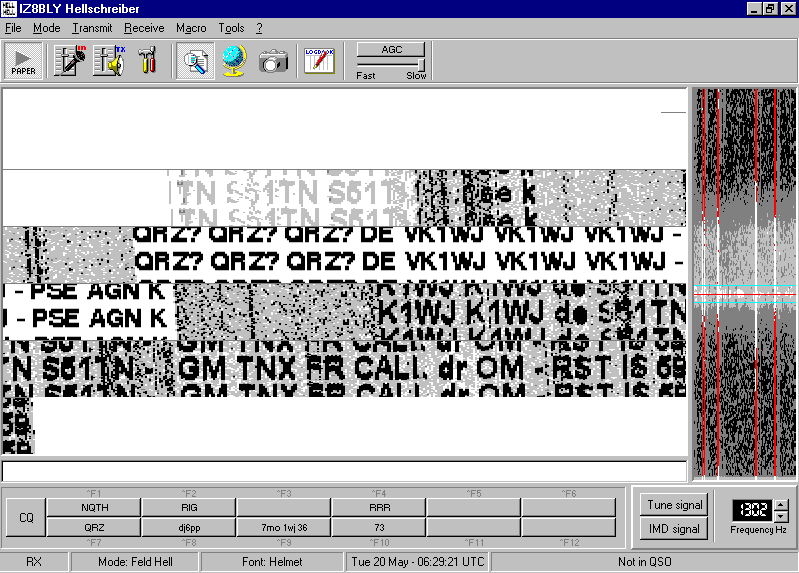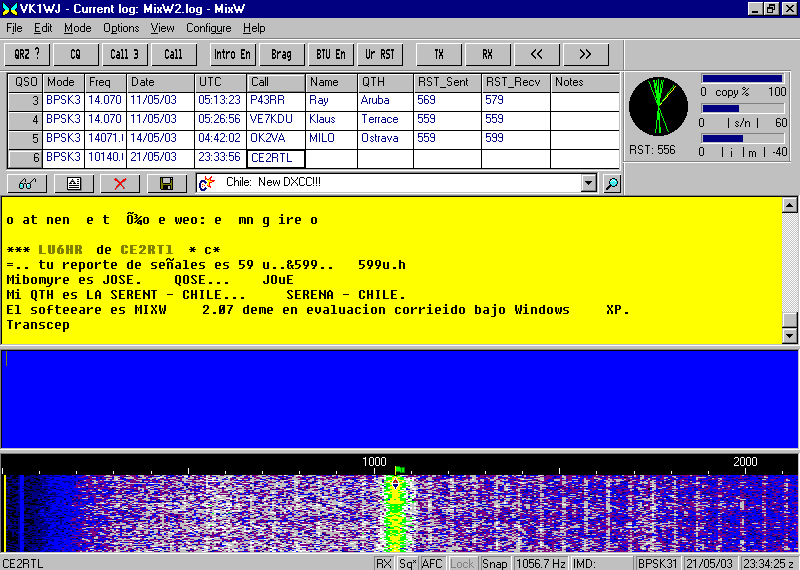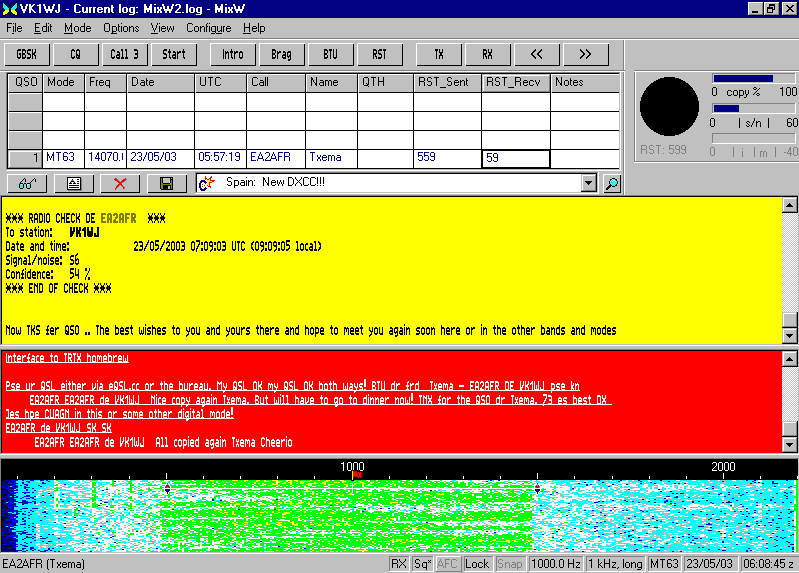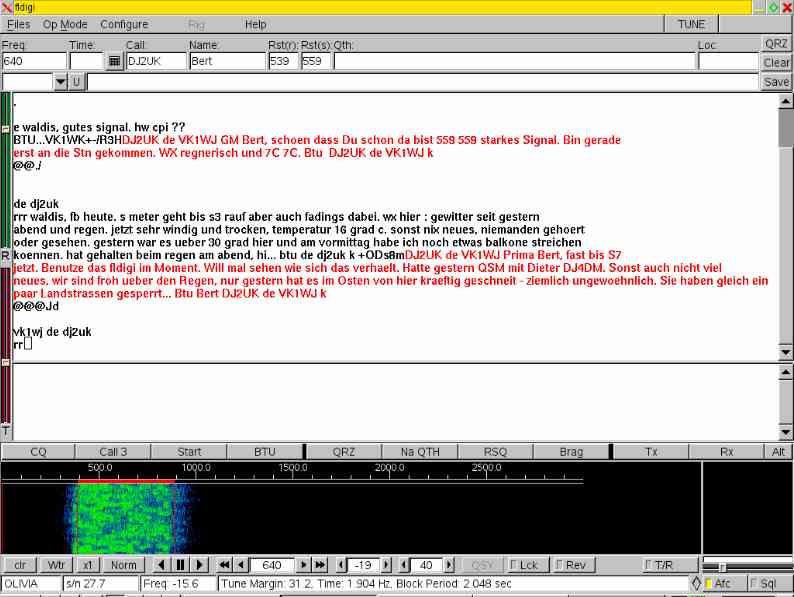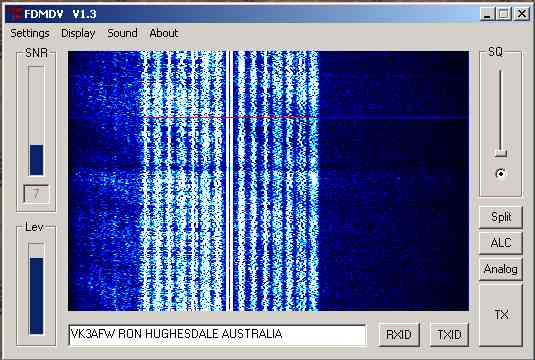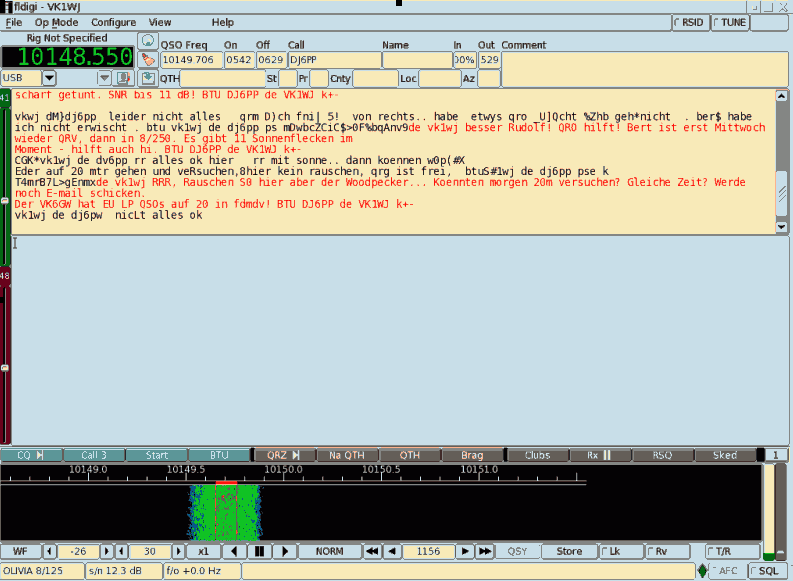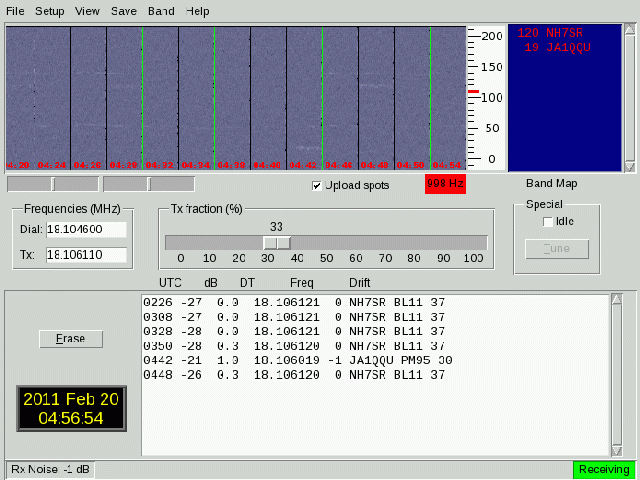A: Any mode that has the information encoded in bit (1-0) format.
Old examples: CW, RTTY, Hellschreiber. For all of these there are mechanical devices available, the Morse key, the old Teletype (I used it extensively with computers in the 1960s), and mechanical Hellschreiber devices.
Newer examples: Packet, AMTOR (FEC and ARQ), PACTOR, GTOR. Mostly TNCs were used for these modes.
New examples: BPSK31, MFSK16, MT63, FSK441, and also digital voice: FDMDV.
Digital modes vary hugely in bandwidth, from around 40 Hertz for PSKAM10 to 2 kHz for MT63.
A: Typically an SSB transceiver running at less than the full power output, 30 to 70 Watts are the average. QRO is sometimes used on VHF, but on HF it is very rare.
The transceiver need not be sophisticated, speech processing is counter-productive for digital modes. All that you require are 4 signals: Ground, PTT, Audio to transmit, and Audio received. Typically these are available at the microphone plug. Of course you can use CAT that is supported by several digital modes programs - if you like to complicate a simple task...
A sharp filter is a good help when there are crowded conditions in the PSK/FSK modes. It avoids the desensitising, that is caused by a strong digital station within the SSB passband of the transceiver.
By the way I found a trick to use my 250 Hz FL-101 CW filter in the IC 706 Mk2 in SSB mode: One has to declare it as an FL-223 in the "Initial Set Mode" procedure. Since the latter may be used in SSB and CW modes, and there is no digital identification on the filters, the IC 706 accepts this.
Many digital stations use simple antennas (like dipoles and verticals), which are completely sufficient in most cases.
Of course you need a computer and an operating system. Software is available for Windows (all flavours from 95 onwards), LINUX, Free BSD and MacOS. The computer must have at least a 16 bit sound card (or integrated sound system), since TNCs are no longer used with the new digital modes. The entry level PC is a 486DX33, with which you can run PSK31SBW and not much else. Faster 486 systems can also run Digipan (the older versions). Many programs will run with a Pentium 133.
Select a monitor that is "RF quiet". There can be huge differences between monitors. Also the screen resolution and colour depth may affect the RF noise generated. As a general rule the lower resolutions and screen sizes are better. It is handy to be able to switch resolutions "on the fly" as with LINUX xorg for instance, this allows you often to shift monitor interference off a frequency of interest!
Also select a keyboard that doesn't "go ape", when it encounters an RF field. As with monitors there are huge differences.
The mouse tail can act as a good antenna - particularly on 6m. Wind it (at the PC end) around a ferrite ring a few times to suppress RF.
If you are interested in digital voice modes you must have an additional sound card. A cheap USB sound system plus a phone / speaker headset is sufficient for that.
If you want a cheap digital modes PC, try Tuesday's Canberra Times "under 100$" classifieds. Many systems offered there are quite sufficient to run digital modes.
Operating systems: Horses for courses! If you want to use Windows for the very low end PCs (up to a Pentium 166) try Windows 95 or 98 SE WITH the Y2K patches (otherwise many programs won't run). Some programs' help files can't be accessed directly from the program under Win 95. More on that later.
If you rather like to run LINUX use a "lightweight" window manager, like IceWm or mwm to minimise resource usage. I myself have used the Mandrake 9.1, Mandriva (from 2008.1 onwards), Mageia and OpenSuse (from 10.2 onwards) distros and as window managers IceWM, JWM, mwm and fvwm. My Asus Eee laptop ran Xandros Linux, which I replaced with Mandriva 2009.1 and IceWm as window manager. This works very well.
Your computer must have the right software. In the meantime quite a few packages are available. I will have a (certainly incomplete) list at the end. Most of them have the possibility to adjust for fast or slow timing chips on the sound card - read their help files on this subject.
All of them use a display called "The Waterfall". This displays part of the AF spectrum (usually 0 up to 4 kHz) horizontally, and the last few seconds of time vertically, with the present being at the top. This just looks like a real waterfall, hence the name!
Between computer and TRTX you have "The interface", the purpose of which is impedance matching, volume adjustment, PTT switching (some people do this with the Vox control), and galvanic separation between computer and TRTX. Optocouplers are often used for PTT, however a small reed relay is much easier. Mostly the RTS signal of a COM-port is used to trigger PTT. The orthodox theory is: "Without galvanic separation you will get too much RF in the computer, which may cause instability and in severe cases ruin the PC". My initial experience was that it did no harm to connect the serial port's "ground" signal to the TRTX' ground when I did PTT via a serial port. This way I could use a simple switching transistor instead of the optocoupler or reed-relay. I ended up connecting TRTX and PC with a thick wire, and there was no instability. Later with an antenna closer to the station the situation changed and I had to use galvanic separation and remove the connecting lead PC/TRTX in order to avoid parasitic af generation.
The interfaces can be quite simple, as the following diagrams show. The first one implements the galvanic separation, the second one doesn't. I have tested both with a TS 50S, an IC 706 Mk2 and an FT857D and they work reliably. Transformer ratios and microphone voltage dividers are fairly uncritical for desktop PCs, but test it out what works for your particular PC/rig combination! Of course you can vary these schematics; feel free to experiment!
Note: If your transceiver has got "digital audio output" with a volume-control independent output level, do not use it. It is very handy to do volume adjustments with the volume knob at the transceiver. Take the audio from a "speaker" or "Headphones" jack and route it (if need be with a small loudspeaker in parallel) to the interface!

|
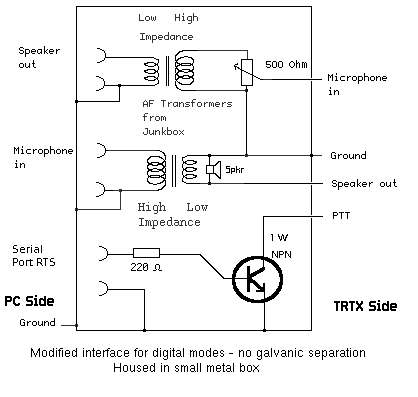
|
My Asus Eee laptop doesn't have serial or parallel ports, so I developed a circuit using VOX switching with a manual switch for modes that pause too often for the VOX circuit to be effective (like Feld Hell or THROB). All components were determined by experiment and are fairly critical. For the VOX I took one of the stereo output channels leaving the other one for audio. Xf1 is an audio transformer 3 ohm to 7 Kohm, Xf2 a 240V to 12V mains transformer and Xf3 an 18V to 240V mains transformer. There is galvanic separation between netbook and TRTX. Note also that the Asus eee PC needs a MONO plug for the microphone-in socket and that the built-in microphone is NOT disabled when the plug is inserted. These days I use a USB dongle as sound system and have the built-in one disabled. All parts are junkbox items:
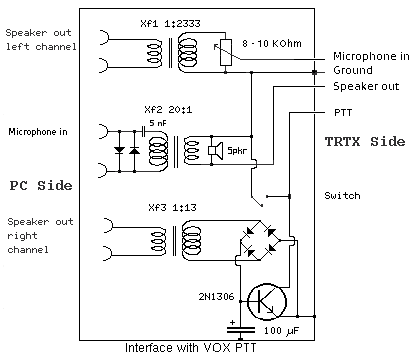
It is IMPERATIVE that the interfaces be as completely encased in metal as possible. Other boxes are suitable only if the shack is free of stray RF. All leads in and out of the interface must be shielded. The connectors to the "Microphone In" and "Audio Out" sockets at the PC sound_card/integrated_sound_system should be of the "Stereo" variety.
A Bare Bones Interface:
This was a fun project of mine. From having the idea until the first QSO there were only about 7 hours (with a dinner break in between).
The idea was to use the absolute minimum of parts - 5 - and still have a useful interface. The junkbox delivered:
- An old loudspeaker in a wooden box
- 2 mains transformers (around 1:10 or so winding ratio)
- 2 sets of 2 phono sockets

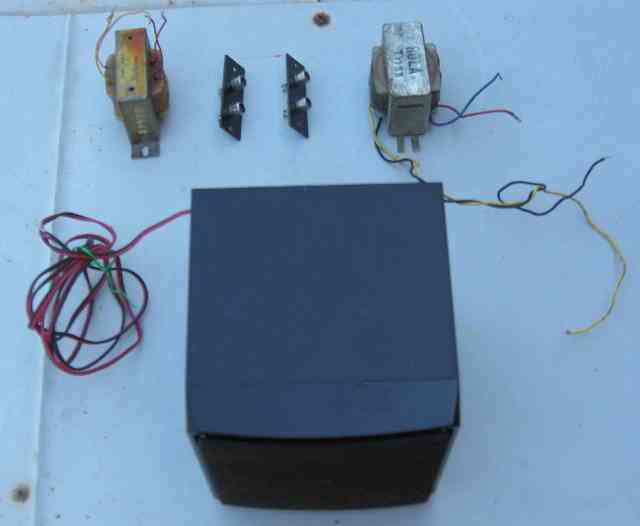
Audio levels have to be set first via the mixer application on the PC, in my case "pulsemixer":
- PC audio out: Master = 76/100, PCM = 79/100.
- PC audio in: Capture = 51/100.
This can be fine tuned via the TRX "volume" control and controls within the digital modes programs used.
Here the first QSO with that interface - using WSJT-X:
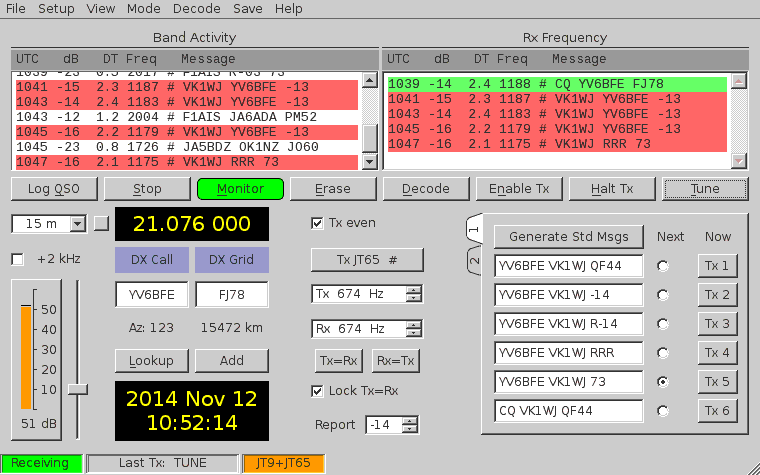
- Most instability problems are caused by "RF in the shack".
If you have high SWR on any coax cable feeding your antenna,
it will radiate, so keep SWR on the cables in your
shack low! A poorly soldered coax-plug will exacerbate the
instability. Another unlikely culprit can be the TRTX
connector to the power supply. A bit of WD40 can work
wonders!
Antennas very close to the station create high field strengths in the shack. I found that my IC 706 Mk2 tolerated RF much better than my TS 50 S. Also in this case the galvanic separation in the interface showed less instability. - Keep unused antenna cables, wiring and metal objects in
the vicinity of the TRTX, the interface, and the PC to a bare
minimum in order to reduce stray RF as much as
possible! An optically pleasing display of your station with
a snake pit of cables "behind the scenes" will cause endless
problems!
- Monitor your outgoing signal - any simple RX will do the job. If it sounds distorted, find the problem and fix it. Do not rely on your QSO partners assuring you that the signal is OK. Many people are just too polite.
A: Generally the high end portions of the CW sections of the bands are used. There are exceptions with the differing band plans in the different IARU regions.
Our band plans have digital modes between 1800-1815, 3620-3640, 7030-7040,10140-10150, 14070-14112, 18100-18110, 21070-21125, 24920-24930, 28050-28150,
On VHF you have 50150-50300, 52000-52100, 144050-144700. On UHF/SHF you can use the "Narrow Band Modes" allocation. In praxi you will arrange skeds. The chances of achieving a random contact in digital modes on UHF/SHF are minimal.
A good summary of the modes together with sight- and sound-examples can be found on http://www.w1hkj.com/FldigiHelp-3.21/Modes/index.htm
For BPSK31, QPSK31 (USB): 3580 (USA, here 3620), 7035, 10140, 14070, 18100, 21070, 24920, 28120.
The modes were developed by Peter Martinez, G3PLX. They are based on RTTY, but use phase shift keying at 50 WPM (31 BAUD). In the QPSK mode, instead of just keying by phase reversals, or 180 degree phase shifts, an additional pair of 90 and 270 degree phase shifts are done. QPSK represents two BPSK signals on the same frequency, one shifted 90 degrees in phase. Both contain half the total power. Bandwidth for both is around 80 Hz.
For PSK63 (and higher), PSK63F, PSK125, PSKFEC31, PSKAMxx (USB): 10140 ff, 14072 ff, 21080 ff. Procedure as PSK31. PSK63 was developed by Moe Wheatley AE4JY and Howard Teller KH6TY. Speed: 74 wpm in capital letters and 102 wpm in small letters (average). Bandwidth 160 Hz. PSK125 is double the speed and bandwidth. PSKFEC31 is upper-case only BPSK31 with added simple FEC, PSK63F is PSK63 with added FEC.
Olivia: For standard 32 tone 1000 Hertz bandwidth Olivia generally the spectrum between 14106.5 and 14108.5 kHz is used. This mode has plenty of configurable parameters. Frequencies for all submodes and bands see: The Olivia Homepage. It basically is a form of MFSK, which is tolerant against frequency differences between the QSO partners. I often run skeds in 8 tone 125 or 250 Hertz and 16 tone 500 Hertz (amongst others) bandwidth Olivia in or just below the MFSK bands.
Contestia: This is very similar to Olivia, but uses only upper case. It is not quite as robust as Olivia, but faster. Frequencies used: Just as Olivia.
For all MFSK modes as well as Domino EX and Thor (USB): 10140 ff, 14072 ff, 21072 ff. Procedure as PSK31.
The modes were developed by Murray Greenman ZL1BPU. MFSK stands for "Multi Frequency Shift Keying". It uses 16 tones, that are shifted in frequency, which results in a quite musical sound. The rate is 42 WPM. Bandwidth around 316 Hz. However I have found that I can use my 250 Hertz filter successfully with MFSK16! MFSK8 uses 32 tones. The rate is 27 WPM. For more details see the MixW and Stream Help files.
Domino EX (the newer version of Domino) is a form of MFSK that is much more tolerant against frequency deviations (for instance in Doppler shift scenarios on VHF). It also looks promising on HF - I still have to do more tests. Similar to Olivia Domino EX has various speeds and can be configured to use or not to use FEC.
Thor is a follow on development from Domino EX. It has FEC integrated. I have tested it against Olivia and the latter is better.
Ros has as distinctive feature a CRC (Cyclic Redundancy Check byte) attached to each transmission allowing you to see immediately if the transmitted data are reliable or not. It has 3 possible speeds and 2 possible bandwidths. The program itself suggests (or if you use CAT enforces) several operating frequencies on the various bands. These are: 130, 500, 1840, 3583, 3585, 3595, (5367), 7039, 7050, 7055. 7115, 10132, 10133, 10134, 14101, 14103, 14111, 14116, 18107, 18111, 21110, 21115, 24916, 24937, 28295, 28297, 50295, 50297, 144160, 144980, 432097.
ROS can be used for chat-mode QSOs and also uploads spots to the internet if you have a connection going.
For Hellschreiber (USB): 3580 (USA, here 3620), 7035, 10135, 14063, 21063 and 28063 kHz. That is the official view, unofficially also the MFSK band is used for Hell. Hellschreiber was developed by Rudolf Hell in 1929. and is still in use today using the original format. During WW2,Hellschreiber was widely used for field portable military communications. Pixels are sent by scanning columns from bottom to top and from left to right at the speed of 122.5 baud (at standard speed). There are 14 dots in each vertical column.
Feld Hell uses "carrier on" for a black dot and "carrier off" for a white dot.
PSK Hell uses phase shift keying like PSK31. The 245 baud version uses the normal 14x7 character matrix and has a bandwidth of 245 Hz. There is also a 105 baud version available in IZ8BLY's Hellschreiber program, that is said to be more suited for weak signal DX.
FM Hell is said to be a "single sideband" version of PSK Hell and uses only half the bandwidth. For Details see the Help-file of IZ8BLY's Hellschreiber program.
There are also Hell 80, Duplo Hell and C/MT Hell - very rarely used.
For MT63 which is the precursor of Olivia the same frequencies are used. The mode has 3 different bandwidth settings (500 Hz, 1KHz and 2 KHz), 2 different "interleave" settings, and is quite fast. I have worked a few stations only in MT63.
For RTTY, AMTOR and PACTOR: 1800-1815, 3580-3600 (USA, here 3620-30), 7035-7045, 10140-10150, 14080-14099, 18100-18109, 21080-21120, 24920-24929, 28050-28150. There is AMTOR FEC and AMROR ARQ as well as PACTOR FEC and PACTOR ARQ. The "FEC" versions are used as any other digimodes, the ARQ versions are as far as I know only available in hf under LINUX.
Throbx and Throb are new DX modes. Frequencies as PSK63 etc. Throbx is a good mode for very poor condx. It is also very slow. There are 3 speeds available: 1, 2 and 4 throbs/sec. The error rate increases fast with the speed.
PSKAM50, 31 and 10 are modes developed by Patrick Lindecker F6CTE. Speeds are 50, 31 and 6 WPM respectively, bandwidths 180 and 40 Hz. Frequencies as PSK63 etc. Perplexingly PSKAM50 is the best of these 3 for long path DX. As far as I know, only the Multipsk program supports the modes.
Chip 64 and Chip 128 are spread spectrum modes with average sensitivity. Frequencies as PSK63 etc.
SSTV can be heard in the SSB band segments and also in the MFSK segments. Official frequencies are 14230, 21340 and 28680.
FDMDV Frequency Division Multiplex Digital Voice and FreeDV have only one "official" frequency - 14.236 USB. The required bandwidth is about 1250 Hz. At the moment your best chance is to arrange a sked.
Look for JT44 and JT65 signals on: 144235 and 144335. Most used is JT65b.
JT65a is also used on the hf bands, try 1.838, 3.576, 7.039, 7.076, 10.139, 10.147, 14.075, 14.076, 18.102, 18.106, 21.076, 24.920 and 28.076.
WSPR is mainly used with QRP power for propagation tests - http://wsprnet.org/drupal/wsprnet/map. Frequencies:1.8366, 3.5926, 5.2872, 7.0386, 10.1387, 14.0956, 18.1046, 21.0946, 24.9246, 28.1246, 50.293 and 144.489.
JT9 is the QSO mode of WSPR. Frequencies generally 2 Khz above HF JT65a. Use WSJT-X for it.
Look for FSK441 signals on: 50230, 144230 and 144330 (though sometimes you arrange different QRGs for skeds). FSK441 could also be used on 10 and 12 metres, but it is said to be "too easy".
FSK441 and JT44, JT65 and JT6M are tolerant of frequency deviations between the stations of up to about 400 Hertz. But it is a good idea to be as close as possible in frequency for skeds.
If you want to work some of the more exotic modes, it is best to arrange skeds for them!
A: On HF: The world. You will rarely get the chance to work VKs. Most activity is on 40, 30, 20, 15 and 10 metres, you must be lucky to get 17 and 12m contacts. From February 2003 I had a weekdaily LP sked with several DL and HB9 stations. We first used 20m but shifted to 30m in 2007 with the cyclical decline of sunspot numbers. I used 80W and either a vertical or a longwire antenna. My QSO partners had similar set-ups. We started out with MFSK16, then used PSKFEC31 (you can SEE even a very weak signal in PSKFEC31 because of the narrow bandwidth), and in 2009 we used Olivia 8 tones 125 Hz, which is ultra sensitive but also very slow. Later we switched to Contestia 8/125 which is equally sensitive but twice as fast as Olivia. Condx allowing one can work EU on 30m LP in the afternoon and SP early morning. I have also worked US stations in the evening there. On 20m one can work the Pacific including the US West coast.
On VHF you can use all the regular HF modes of course. In praxi you find firstly FSK441, which is a specialised mode for Meteor Scatter communications. It enables contacts on 50 MHz and on 144 MHz between 500 and 2500 km. FSK441 has largely displaced 5 to 10 speed Hellschreiber, that was commonly used until a few years ago. Contacts between VK and ZL can be achieved fairly regularly.
The other modes used are JT65 and some more exotic WSJT modes, mainly for EME contacts, but also for tropo-scatter.
I experimented with Aircraft enhancement on 2m using BPSK63 and BPSK125 and other fast modes. I describe the operating procedures here
A: Without a doubt BPSK31. If you want to get into digital modes try this one first on 14070 or 21070.
Sometimes you hear BPSK63 and BPSK125. Then there are JT65A, Olivia, Domino EX and MFSK16. Modes go in and out of fashion quite quickly!
Other modes heard "randomly": Hell (Feld and FM), MT63, PSKFEC31, THROB.
There are still a lot of RTTY stations on the bands. I wonder, why they bother, since so much more effective modes are available.
A: This is a hard one to answer. I have done a few tests with the most promising modes.
If you are after lowest S/N ratio for a contact there is WSPR then JT65A. These are for report exchanges and minimal chat - for bare bones QSOs only. JT65A is usable down to -30 dB S/N, WSPR is a few dB better.
For "chat" modes: From my experience I would rank the Olivia modes first: 8 tones 125 Hz is very sensitve but also very slow, then come 8 tones 250 Hz, 16 tones 500 Hz, and 32 tones 1 Khz, to name the most common. Behind Olivia comes ROS, then Domino EX with FEC, then PSKFEC31, MFSK8 (which is slightly better than MFSK16), then PSK63F, PSKAM50, QPSK31, and BPSK31. The very narrow band and slow modes like PSKAM10 easily lose sync when subject to fading. RTTY has no error correction capabilities and requires around 200 Hz bandwidth; it is a good condx mode, basically superseded, but it still has a lot of fans. I haven't included other modes like Thor, MFSK4, MT63 or FMHell for instance, since I have not enough QSO data with them to make a comparison meaningful.
Here a few figures from Patrick, F6CTE (author of Multipsk):
Lowest S/N for 2% errors: -9 dB for BPSK31 (for white noise in a 3 kHz bandwidth), -6 dB for QPSK31.
Lowest S/N for 2% errors: -11 dB for PSKAM50 and -19 dB for PSKAM10 (for white noise in a 3 kHz bandwidth).
Lowest S/N for 2% errors: - 7 dB for PSK63 (for white noise in a 3 kHz bandwidth).
However the "white noise" scenario does not match reality very often. In every test I did, QPSK was better than BPSK. Also it is possible to use sharp CW filters for all the PSK modes, MFSK 8 and 16, Olivia with 250 Hz bandwidth and RTTY, all of which fit through a 250 Hertz filter.
Here is a table that gives some idea of the relative speeds of various modes. It is the time to transmit a 2 line CQ call:
| B/QPSK250: |
4 sec |
| Domino EX 22: |
7.5 sec |
| B/QPSK63: | 11 sec |
| Domino EX 11: |
14 sec |
| RTTY, Amtor Fec, Hell 80: | 15 sec |
| Olivia 4/500, B/QPSK31: |
20 sec |
| MFSK16: |
23 sec |
| PSKAM50: | 25 sec |
| Contestia 8/250: |
27 sec |
| Domino EX 5: | 29 sec |
| PSKFEC31, MFSK8: | 33 sec |
| PSKAM31: | 37 sec |
| Olivia 16/500: |
39 sec |
| Olivia 8/250, Domino EX 4: | 40 sec |
| PSK10: | 50 sec |
| Contestia 8/125: | 52 sec |
| THROBX (1): | 74 sec |
| Olivia 8/125: |
97 sec |
| PSKAM10: | 118 sec |
A: Most software is "Freeware", some is shareware, which you must either register after a while, or - after it stops working - expunge from the system and re-install, which however is illegal and immoral...
Digipan is freeware, running BPSK31, QPSK31, BPSK63 and FSK31, as well as PACTOR receive. Download version 2.0 digipan20.zip, the .exe version does NOT work (cannot be installed).
URL to download: www.digipan.net
Hamscope is freeware. It runs BPSK, QPSK, CW, MFSK16 natively and RTTY using the MMTTY engine as well as Packet using the SV2AGW packet engine. For all of these modes a Pentium 133 is sufficient. Ignore the advice, that you need a certain colour depth on your display. If works just fine with 16 colours! Newest version: 1.56.
URL to download: www.qsl.net/hamscope
IZ8BLY Stream is freeware too. It runs BPSK, MFSK16, MFSK8, PSK63F and PSK125F. Note that under Win 95 the help file is not accessible from the program itself, but has to be set up using a separate shortcut. This is true for all IZ8BLY's programs.
URL to download: http://antoninoporcino.xoom.it
This one really works! Nino has changed ISPs often!
MixW is shareware. It can do BPSK, QPSK, CW, RTTY, AMTOR FEC, Feld Hell, FM Hell (105 and 245 Baud), MT63, Throb, FSK31, Olivia, Contestia, RTTYM, SSTV, and RX in PACTOR and AMTOR ARQ. Additionalv modes can be defined within Macro buttons. Useful are: BPSK63, QPSK63, BPSK125 and QPSK125. Many MixW users transmit pictures of themselves whilst working MFSK16 (dynamic switch). Add-ons required for Olivia, Contestia and RTTYM. As far as I know MixW costs 50 $US.
URL to download: www.mixw.net/
Multipsk is freeware. It runs BPSK31, QPSK31, CW, CCW, RTTY, AMTOR FEC, PACTOR1 FEC, Feld Hell, PSK Hell (245 Baud only), FM Hell, Hell 80, MT63, BPSK63, QPSK63, BPSK125, QPSK125, PSK63F, PSK220F, PSKFEC31, PSKAM50, 31, 10, Throb, Throbx, MFSK16 and MFSK8, ASCII, RTTY, HF Fax, Olivia (5 different modes), Contestia, Chip 64 and 128. Domino and Domino EX, JT65 A,B,C and some other less known modes. It also allows you to listen to AMTOR ARQ and PACTOR ARQ. Dynamic SSTV reception and transmission (just like MixW) is also provided. A new feature is the possibility to identify the TX mode with a Reed-Solomon identifier at the start of each transmission, and also to lock on to transmitted RS identifiers (mode and QRG). A shareware version with enhanced functionality is available too.
Multipsk runs also under WINE in Linux.
URL to download: f6cte.free.fr/
MMTTY is freeware. It can do RTTY.
URL to download: MM hamsoft TTY
MMSSTV is freeware. It can do SSTV.
URL to download: MM hamsoft.SSTV
FreeDV is freeware. It can do FreeDV and also normal analogue SSB.
URL to download: http://freedv.org/tiki-index.php For more information on FreeDV follow this link.
FDMDV is freeware. It can do FDMDV and also normal analogue SSB. It is the version of Digital Voice before FreeDV appeared.
URL to download V1.3: www.n1su.com/fdmdv URL to download V1.2: ik4hdq.net/fdmdv.htm.
For more information on fdmdv follow this link.
IZ8BLY Hellschreiber - freeware - can do Feld Hell, PSK-Hell, FM-Hell (the latter 2 in 105 Baud and 245 Baud), Duplo-Hell and C/MT Hell. The latter is a funny mode, where you actually see the letters in the waterfall. It also can do 1/8 speed and 5, 9 and 10 speed of all modes.
URL to download: http://antoninoporcino.xoom.it
IZ8BLY MT63 - freeware - can do MT63 in 3 bandwidths - 2 kHz, 1 kHz (the most popular), and 500 Hz.
URL to download: http://antoninoporcino.xoom.it
PSK31SBW - freeware - can do BPSK31, QPSK31 and CW (the latter transmit only). It has a tiny waterfall and should be used only if your PC won't run anything better. I had to convince its author, that it REALLY ran on a 486DX33.
URL to download: www.qsl.net/wm2u/p31sbw108.zip
WSJT by K1JT - THE VHF digital modes standard is also freeware and provides JT2, JT4, FSK441, JT64, JT65, JT6M and (in versions 7 only) WSPR. JT44 is no longer available in version 4.xx and above of WSJT. Download version 3 for this mode! Versions 3 can co-exist with others, as long as you use different directories for them.
URL to download: physics.princeton.edu/pulsar/K1JT/
Here the installation instructions for Linux Mageia.
I have experienced that during Meteor Scatter skeds you sometimes get FSK441 stations coming in via aircraft enhancement. If there is no QSB on such signals they may be very hard to decode. In this case make your own QSB by wobbling the "Volume" knob at your TRTX. Simple but VERY effective!
WSPR - freeware and also by K1JT can do WSPR.
URL to download: physics.princeton.edu/pulsar/K1JT/
Here the installation instructions for Linux Mageia.
WSJT-X - freeware and also by K1JT can do JT65a and JT9. It has a very much more user-friendly interface than WSJT!
URL to download: physics.princeton.edu/pulsar/K1JT/
Here the installation instructions for Linux Mageia.
Olivia - freeware - can do the various configurable Olivia MFSK modes. It is available for LINUX as well as for Windows.
URL to download: http://n1su.com/olivia/.
For LINUX users: The easiest way is to use gMFSK.hkj or Fldigi. More complicated and less user-friendly is the following: Download mfsk_trx.tgz and unpack it, giving you the ncurses based mfsk_trx program. It doesn't have PTT, so you have to use the VOX on the TRTX. It is very compact and straight-forward.
For Windows users: The easiest way is to use Multipsk, which will work on all Windows platforms from 95 up. More complicated and less user-friendly is the following: Download OliviaAidsetup.zip and unzip it, then install Cygwin etc. This works under XP and 2000. However under ME it does NOT work properly.
Fldigi - freeware - can do B(Q)PSK31, 63, 125, 250, Feld Hell (1, 5, 9 speed), FSK Hell, FSK Hell 105, Slow Hell, Hell 80, MFSK4, 8, 11, 16, 31, 32 and 64 (including picture transfer from 16 upwards), MT63 (500, 1000, 2000 Hz), RTTY (all kinds of baud rates and offsets), Thor (4, 5, 8, 11, 16, 22) Olivia (various modes), DominoEX (4, 5, 8, 11, 16, 22), THROB and THROBX (1, 2, 4 Throbs/sec), CW and WWV (for soundcard calibration). It runs under LINUX, Windows XP and Windows Vista. I have tested it with OpenSuse 10.2, 10.3, Mandriva 2008-1, 2009-0 and Mageia 1.
URL to download: http://www.w1hkj.com/Fldigi.html.
Fldigi is developed vigurously and every new version shows improvements compared to older ones!
gMFSK.hkj V53 - freeware - can do BPSK31, QPSK31, BPSK63, QPSK63, Feld Hell, Feld Hellx5. Feld Hellx9, Slow Hell, FSK Hell, FSK Hell 105, Hell 80, MFSK16, MFSK16_pix, MFSK8, RTTY (all kinds of baud rates and offsets), MT63, Olivia (various modes), DominoEX (various modes), THROB (various modes) and CW. It runs under LINUX. I have tested it with Mandrake 9.1, OpenSuse 10.2, 10.3, Mandriva 2008 and 2009 - See my LINUX page for prerequisites and other details.
URL to download the source archive: http://www.w1hkj.com/#gmfsk.
hf 0.7.3 - freeware - can do AMTOR (FEC and ARQ), PACTOR 1 (FEC and ARQ), RTTY, GTOR, MT63. It too runs under LINUX. So far I have tested it only on RTTY and didn't like the user-interface. Download the rpm hf-0.7.3-0.i386.rpm from the rpm repository http://rpmfind.net/
ROS by EA5HVK - freeware - can do the ROS modes only. Download from: http://rosmodem.wordpress.com/ - bypass the "dropbox" by not creating an account but downloading directly.
The ROS Guide URL on the rosmodem site is incorrect. The correct one is http://www.qsl.net/g0hdi/ROS.htm.
Easypal by KC1CS - freeware - can do image and text transfers. Download from: http://www.kc1cs.com/
I have very little experience with it.
PSK2k by DJ5HG - freeware - does meteorscatter contacts. Download from: http://www.dj5hg.de/dj5hg_download.html
I have tested it only once. It is a CPU hog and generally inferiour to WSJT.
These are the programs I have used. There are of course others. Each program has got its idiosyncrasies, and each one uses different syntax for its "Macro Buttons". Each program also has its own "Set-up" procedure, where you enter your callsign, the COM-port and signal (RTS or DTR) used for PTT, as well as the incoming sound port (Microphone-in or Line-in). If you use more than one program, make sure all these settings are the same in all programs that you use!
A: Normally the TRTX is tuned to a frequency below the operating QRG, and USB is used, giving one a spectrum the size of the SSB filter passband to play with.
Tuning the various signals is done by clicking on them in the waterfall. If you don't like simplicity and rather prefer having a hard time with various hard- and software incompatibilities and other problems, use CAT!
Switch on the PC. Enable in "Volume Control" "Recording" the microphone input. On Windows systems this can be done by running Sndvol32.exe and Recorder.exe in "StartUp", and having a pre-recorded sequence of keystrokes played back by the recorder, if you don't want to do it manually each time at boot. LINUX systems remember these settings if you save them in aumix and run aumix -L in the start-up script for X. This however does not work for the new "pulseaudio" system, which needs readjustment with "alsamixer" at every start-up. I prefer not to use pulseaudio.
Start your favourite program and switch on the TRTX. Select USB. Tune to the desired QRG and tune-up on a free frequency within the passband. A tune-up facility is available in most programs.
Set a good input level for a pleasant display. Required levels vary from barely audible (MixW) to full throttle (IZ8BLY Hell). This can be done with the Volume Control Microphone level virtual slide control.
Listen out for a CQ call or the end of a QSO or call CQ. When you do that, adjust the output level to the power desired (less than 100% of the maximum level available for your TRTX, lest it overheats). This is done with the interface potentiometer, after a rough setting with the "Wave Volume" virtual slide ruler. Normally you set this slide ruler only once. It remembers the setting for the next boot. CQ calls are normally programmed into a "button" of the program, which switches to TX, sends the CQ call and then reverts to RX.
Make sure, that you switch the "AFC" (or in Multipsk "Slave") and "Net" controls in your program on, when in a QSO. Since the frequency must be pretty much spot-on for decoding (except for Olivia and Domino EX), and even modern TRTX "wander" a few Hertz every now and then. AFC is more effective with some programs than with others. It pulls the RX frequency to the signal of the station you are listening to, even if that station wanders a bit. "Net" forces the TX frequency to your last RX frequency.
I find it good to watch the quality of my own signals by having an old communications receiver with the antenna short circuited to earth tuned to my frequency. This way I can stop any spurious transmissions. This is especially important, when setting up a station for the first time!
When in a QSO you normally have the basic information like name and QTH and station description programmed into "buttons", which can be activated for transmission with a mouse-click. Nearly all programs also have an integrated logging facility, which enables you to collect call, name, band, mode, date and time, reports sent and received etc. into a file. The programs also have the facility to create an .adi file from the log entries. This file may be uploaded directly to the eQSL.cc website for electronic QSLing. All programs allow you to "pre-type" QSO text, whilst your QSO partner is sending, saving you time and enabling you to answer to questions as soon as you see them on the screen.
Special considerations must be given to the FSK441, JT44, JT65, JT6M and WSPR modes. For these you have to set your PC clock very accurately, since stations take turns to transmit during an interval of 30 or 60 seconds and to listen during the subsequent interval. In FSK441 normally the station to the south or east sends in the first 30 seconds of a minute. In JT65 "sending first" means sending every even minute. In WSPR "sending first" means sending every 2 minutes when the starting minute is divisible by 4 (i.e. 0, 4, 8,...). If you arrange a sked, specify who will "send first". To adjust your PC clock listen to BPM, WWV or WWVH (Hawaii) on 5, 10 or 15 MHz, have the PC clock set to the next minute, and apply the setting as soon as you hear the full minute beep. To compensate for reaction time, set the clock 1 second ahead, and hit the Enter key with leisure. There are more accurate methods (like syncing the PC clock to an Internet NTP time server), but this is the simplest, and totally sufficient for JTxx and FSK441. Since most PC clocks are notoriously inaccurate, adjust them shortly before commencing the WSJT session.
On my Software Page I have a little FreeBasic program to do this conveniently. It is usable under Windows and Linux.
Note also that your TX frequency must be within 400 Hertz of your QSO partners. Some TRTX frequency displays can be out by several 100 Hertz on VHF/UHF!
If you want to get into VHF digital modes, try FSK441 (Mode A) on Saturday and Sunday between 6 and 8 AM. Normally it is on 144230, with VK7, VK3 and VK5 beaming towards the N and NE, whereas VK1, 2 and 4 beaming towards VK7 - VK5. A "post mortem" is held at 8 AM on 7083, normally with Rex, VK7MO being net-controller. FSK441B is no longer used during these sessions, but you can of course set up private skeds for this mode. I have had QSOs in FSK441 (A and B) and JT44, but only few in JT6M or JT65. Please read also Rex' article "Digital DX Modes" on page 52 of AR, the May 2003 edition.
Sequences to use for FSK441 (Australian de-facto standard, internationally there are many variations):
1. Calling CQ:
CQ Owncall
2. Answering a CQ:
Callsign/report Owncall
3. Answering a report sent to you:
Callsign/Rreport Owncall
4. Answering such an R-prefixed report:
Callsign/RRR Owncall
5. Answering such an RRR:
Callsign/73 Owncall
Sequences to use for JT65 on HF (De-facto standard):
1. Calling CQ:
CQ Owncall 4-digit MHD-Locator Example: CQ VK1WJ QF44
2. Answering a CQ:
Callsign Owncall 4-digit MHD-Locator Example: DJ6PP VK1WJ QF44
3. Answering such a call:
Callsign Owncall prefixed 2-digit report in dB S/N - may be negative Example: DJ6PP VK1WJ -28
4. Answering a report sent to you:
Callsign Owncall Rreport Example: DJ6PP VK1WJ R-19
5. Answering such an R-prefixed report:
Callsign Owncall RRR
6. Answering such an RRR:
Callsign Owncall 73
There are some shortcuts, for instance the predefined sequence in WSJT is mostly used for EME:
1. Calling CQ:
CQ Owncall 4-digit MHD-Locator
2. Answering a CQ:
Callsign Owncall 4-digit MHD-Locator
3. Answering such a call:
Callsign Owncall OOO
4. Answering the OOO sent to you:
RO
5. Answering the RO report:
RRR
6. Answering the RRR:
73

